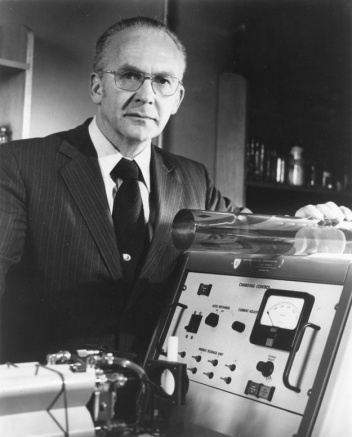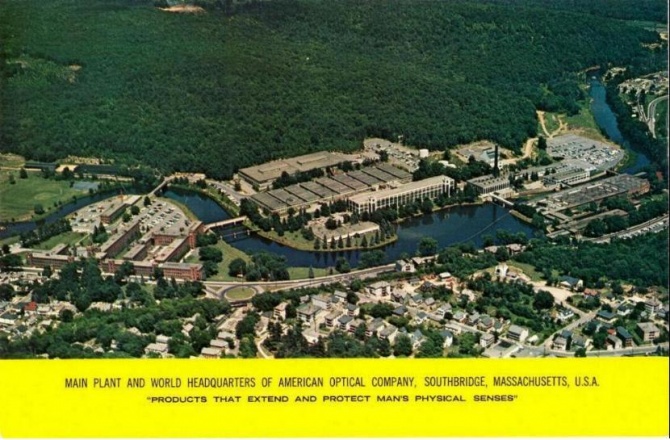Milestone-Nomination:First Optical Fiber Laser and Amplifier
Docket Number: 2012-01
Proposal Link: https://ethw.org/Milestone-Proposal:First_Optical_Fiber_Laser_and_Amplifier
The First Optical Fiber Laser and Amplifier, 1961-1964
In 1961, Elias Snitzer and colleagues constructed and operated the world's first optical fiber laser in the former American Optical complex at 14 Mechanic Street. Three years later this team demonstrated the first optical fiber amplifier. Fiber lasers that can cut and weld steel have since become powerful industrial tools and fiber amplifiers routinely boost signals in the global optical fiber network allowing messages to cross oceans and continents without interruption.
Elias Snitzer, and colleagues developed the first working optical fiber laser and amplifier between 1961 and 1964 at the old American Optical plant in Southbridge MA. The development of the fiber laser drew from Snitzer's earlier work culminating in the first solid-state laser made of glass in 1961 plus his work in optical fibers in which he was the first to report the theory and observation of modes in an optical fiber. This ground-breaking combination of these two then-young technologies was many years ahead of its time.
This work is documented in the following articles:
E. Snitzer and J. W. Hicks, "Optical Wave-Guide Modes in Small Glass Fibers, I Theoretical," paper TB36, Program of the 1959 Annual Meeting of the Optical Society of America, Vol 49, p. 1128, November 1959.
H. Osterberg, E. Snitzer, M. Polanyi, R. Hilberg, "Optical Wave-Guide Modes in Small Glass Fibers, II Experimental," paper TB37, Program of the 1959 Annual Meeting of the Optical Society of America, Vol 49, p. 1128, November 1959.
E. Snitzer, "Optial MASER Action of Nd+3 in a barium Crown Glass," Physical Review Letters, Volume 7, Number 12, pp. 444-446, December 15, 1961.
Charles J. Koester and Elias Snitzer, "Amplification in a Fiber Laser," Applied Optics, Volume 3, Number 10, pp. 1182-1186, October, 1964.
Snitzer is shown here with a Nd-doped glass rod in a photo from the early 1960s. Historical images of the American Optical plant from that period are also shown below.
The advent of optical fiber amplifiers was vital in building the high-speed backbone of the global telecommunications network, which carries our words, pictures and data around the planet. More recently, fiber lasers have become powerful tools in manufacturing, generating multikilowatt beams that can cut and weld materials from plastics to metals.
Other early solid-state lasers, such as the ruby laser demonstrated by Theodore Maiman in 1960, another IEEE Milestone, were made of bulk materials. The fiber laser uniquely transmits the light it generates along a light-guiding core, concentrating its energy in a small area inside the glass, and making it easy to transfer light from a fiber laser into a passive optical fiber for transmission.
Similarly, the optical fiber amplifier acts on light propagating in a fiber’s core. This became particularly important long after Spitzer’s work when fiber-optic communications emerged in the 1970s. Optical signals needed to be amplified after passing through tens of kilometers of glass and initially this required converting the signals into electronic form for amplification. Innovations by Payne and others (see below) led to the development of optical fiber amplifiers which could boost signals in the important 1.5 micron telecommunications wavelength band. The advent of optical fiber amplifiers suitable for communications enabled today’s broad-band fiber networks which carry signals across continents and under oceans and provide the bandwidth necessary to transmit our words, pictures and data around the planet without interruption.
The work that led to today’s communications optical fiber amplifiers is documented in a number of publications including the following:
Poole, S. B., Payne, D. N., and Fermann, M. E.: 'Fabrication of low-loss optical fibres containing rare-earth ions', Electron. Lett.,1985, 21, pp. 737-738, August 1985.
R. J. Mears, L. Reekie, I.M. Jauncey, D. N. Payne, "Low-Noise Erbium-Doped Fibre Amplifier Operating at 1.54um," Electronics Letters, Vol 23, No. 19, September 1987.
E. Desurvire, J. R. Simpson, P. C. Becker, "High-gain erbium-doped traveling-wave fiber amplifier," Optics Letters, Vol. 12, No. 1, pp. 888-890, November 1987.
Fiber lasers also have proved exceptionally well suited for efficiently generating high-quality beams with powers reaching many kilowatts in strength, greatly expanding the applications of lasers in cutting, welding and other machining of materials.
The letter is necessary in order to process your nomination form. Click the Attachments tab to upload your letter.
Milestone Proposal references.doc


